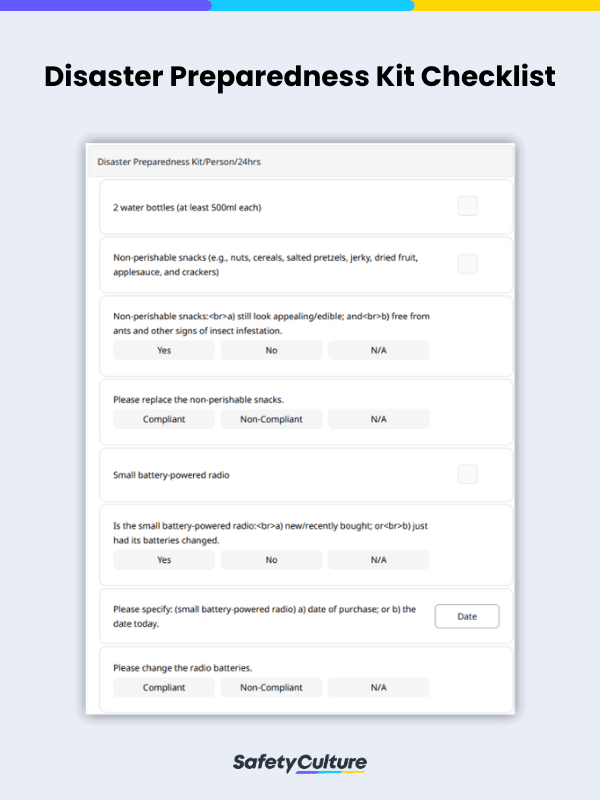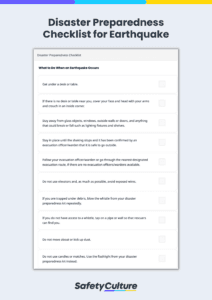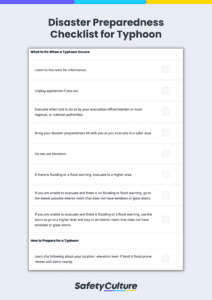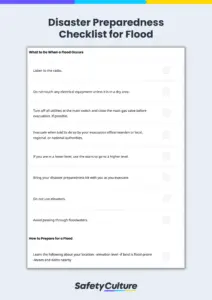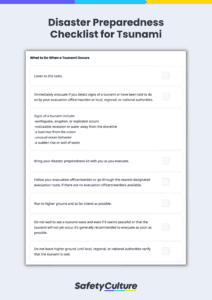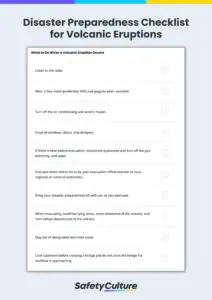What is a Disaster Preparedness Kit?
A disaster preparedness kit is a curated collection of items and supplies that helps individuals and groups survive disaster and escape unharmed. Without a disaster preparedness kit, employees don’t have what they need to get through an emergency safely.
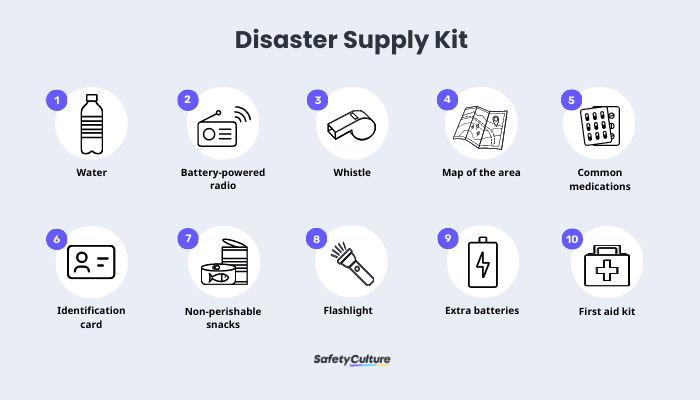
Disaster Supply Kit | SafetyCulture
What to Put in a Disaster Preparedness Kit?
The following are disaster preparedness kit essentials:
- 2 water bottles (at least 500ml each)
- Non-perishable snacks (e.g., nuts, cereals, salted pretzels, jerky, dried fruit, applesauce, and crackers)
- Small battery-powered radio
- Flashlight
- Extra batteries for the radio and flashlight
- Whistle
- First aid kit
- Laminated and updated map of the area (including places where one can seek shelter)
- Antibacterial moist towelettes or disinfecting wipes
- Common medications (such as pain relievers, anti-diarrhea, and antacids)
- Identification card (name, workplace, blood type, current medications, known illnesses, emergency contact and their number, home address, etc.)
The disaster supply list above is only meant to last one person for 24 hours. For shared disaster preparedness kits (e.g., 1 kit for the entire workplace) and those that need to last longer than 24 hours (e.g., several days), there should be larger quantities of all items.
How to Maintain a Disaster Preparedness Kit?
Businesses can maintain their disaster preparedness kits by doing the following:
- Replace non-perishable snacks that no longer look appealing or which have been infested by ants and other insects.
- Change the batteries of the radio and the flashlight, even if they haven’t expired.
- Sanitize and clean the whistle if it’s not stored in a sealed plastic bag or container.
- Check the contents of the first aid kit and note down if there are any missing supplies.
- Verify that the map of the area is correct, updated, and easily readable.
- Replace antibacterial moist towelettes or disinfecting wipes that have dried up.
- Check the expiry dates of the common medications in the disaster preparedness kit.
- Issue a new identification card if employee details have changed.
- Add extra items which may be relevant to the current season such as mittens, earmuffs, and scarves for winter and portable battery-powered or manual hand fans for summer.
- Use a disaster preparedness checklist.
Disaster Preparedness Steps
Protect your employees and business against unprecedented disasters by planning ahead of time. Follow these steps to ensure that your business is prepared in case of emergencies:
- Identify hazards – First, learn about the common and not-so-common types of disasters that are likely to occur in the area of your business. Location is a huge factor to consider so prepare for each recognized disaster. Assess risks—internally and externally–that may happen because of these disasters.
- Learn about emergency management – Be knowledgeable about the local emergency organizations present in your area and learn how to contact them. Create an emergency plan solely for your business—consider guides from government agencies, emergency organizations, and your own safety management experts.
- Prepare supply chain – Assess the company’s appetite for disasters to be able to prioritize areas that would heavily affect business operations if not addressed. Proactively monitor for threats and continuously optimize business continuity plans to make them intuitive.
- Assemble a disaster preparedness kit – As mentioned above, prepare a disaster kit that would last for a certain period. Make sure that employees are aware of its location, and check now and then to replace expired items and restock the supplies as needed.
- Determine the best evacuation plan – As part of your business’s emergency management, specify the best evacuation routes in the facility and let employees know about them. In addition, describe in detail what best to do before and during an evacuation.
- Train on first aid and CPR – If possible, conduct first aid training, emergency response training, and other safety-related training that employees can participate in. This helps ensure that workers are well-versed in these kinds of procedures and can attend to each other if needed.
- Practice the emergency plan – The best way to know if a plan works is to test them—this goes with emergency plans as well. Hold drills and simulation exercises so that employees are consistently refreshed about each step. Update and enhance the plan continuously while emphasizing the safety of employees.
What is a Disaster Preparedness Checklist?
A disaster preparedness checklist is a tool provided by workplaces to their employees to help them respond to emergencies calmly and effectively. It may contain instructions on how to maintain their disaster preparedness kits or outline the steps they need to take during an emergency.

